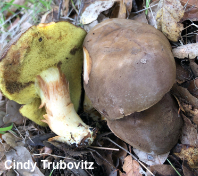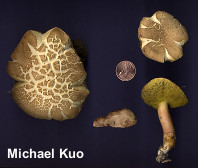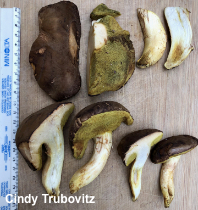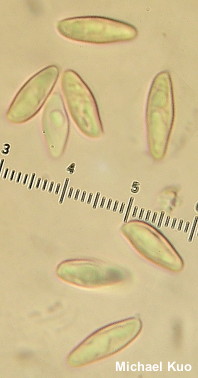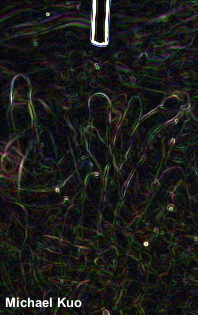| Major Groups > Boletes > Xerocomus subtomentosus |

|
[ Basidiomycota > Boletales > Boletaceae > Xerocomus . . . ] Xerocomus subtomentosus agg. by Michael Kuo, 6 June 2025 Xerocomus subtomentosus is a classic species, first described by Linnaeus (1753). Over the centuries Linnaeus's concept (pretty much this: a sub-velvety bolete with a yellowish cap and stem) has been refined; currently the species is recognized as a hardwood-associated bolete with a yellowish to brown, sub-velvety cap, a stem that sometimes becomes longitudinally ribbed and usually features tiny reddish granules and white basal mycelium, and flesh that sometimes turns blue when sliced. A drop of ammonia applied to the cap surface usually results in a dark red color change. Under the microscope, the pileipellis of Xerocomus subtomentosus is a trichoderm. But even this contemporary, more limited concept for Xerocomus subtomentosus probably encompasses several—or many—phylogenetic species. The "true" Xerocomus subtomentosus must come from Sweden, by virtue of the fact that Linnaeus first described it from there. But are southern European versions, associated with very different trees, the same thing? And here in North America, where we have versions spread out across fantastically different ecosystems thousands of miles apart, is Xerocomus subtomentosus really the same from coast to coast? Doubtful. In fact a 2006 study (Taylor and collaborators) of the subtomentosus group found new species and potential new species on both continents. The authors named one new species, Xerocomus chrysonemus, from the United Kingdom—and, in a subsequent publication (2007), named Xerocomus silwoodensis from southern Europe. The former species is characterized by its bright golden basal mycelium, bright yellow flesh, and shorter, wider spores; the latter species also features shorter, wider spores, and associates with poplars. If you have a well-documented subtomentosus-like collection you would like to contribute to further study of this species group, please see this page. Xerocomus subtomentosus is the "type species" for the genus Xerocomus, which was first recognized by Quélet in 1888. In general, Europeans have used the genus name Xerocomus since then, but most North American authors (myself included) have avoided it. However, contemporary DNA studies of the boletes (see for example Wu and collaborators, 2014 ) make it clear that the species centered around Xerocomus subtomentosus are, indeed, not very closely related to Boletus edulis, which is the type species for Boletus. The genus Xerocomus, in its contemporary sense, can be separated from most other boletes by virtue of its yellow, xerocomoid tubes (which tear apart when separated), and its pileipellis, which is usually a trichoderm rather than a palisadoderm. Additional differences can be detected with really intense microscopy and with scanning electron microscopy, but let's not go there (if you really care, see Šutara, 2008). Thanks to Michelle Lierl, Marissa Myers, and Cindy Trubovitz for documenting, collecting, and preserving Xerocomus subtomentosus for study; their collections are deposited in The Herbarium of Michael Kuo. Description: Ecology: Mycorrhizal with a wide variety of hardwoods (including oaks, beech, birches, aspens); growing alone, scattered, or gregariously; summer and fall, or over winter in warm climates; originally described from Sweden; widely distributed in Europe and North America (but see comments above); also known from Asia and Oceania. The illustrated and described collections are from California, Colorado, Illinois, Indiana, and Washington. Cap: 3–9.5 cm; convex, becoming broadly convex; dry; finely velvety; brownish yellow to brown, yellowish brown, or olive brown; often becoming cracked in age. Pore Surface: Yellow, becoming olive yellow with maturity; often bruising blue, or not bruising; pores xerocomoid, 1–3 per mm; tubes to 10 mm deep. Stem: 4–7.5 cm long; 1–2 cm thick; equal above a tapered base; dry; solid and tough; sometimes ribbed near the apex or over the upper half, but not reticulate; usually featuring tiny reddish granules on a whitish to yellowish surface; basal mycelium white. Flesh: White; usually turning pale blue in the cap when sliced. Odor and Taste: Not distinctive. Chemical Reactions: Ammonia dark red on cap; negative on flesh. KOH red to orangish on cap; orangish on flesh. Iron salts negative to gray on cap; negative to gray on flesh. Spore Print: Olive to olive brown. Microscopic Features: Spores 10–14 x 3.5–5 µm; boletoid-fusiform; smooth; dull yellow in KOH. Hymenial cystidia inconspicuous; 25–40 x 5–10 µm; lageniform or fusiform; smooth; thin-walled; smooth; hyaline. Pileipellis a collapsing trichoderm; golden in KOH; elements 5–12.5 µm wide, smooth; terminal cells cylindric with rounded apices. REFERENCES: (Linnaeus, 1753) Quélet, 1887. (Fries, 1821; Saccardo, 1888; Coker & Beers, 1943; Singer, 1945; Snell & Dick, 1970; Smith & Thiers, 1971; Grund & Harrison, 1976; Baroni, 1978; Smith, Smith & Weber, 1981; Arora, 1986; Breitenbach & Kränzlin, 1991; Phillips, 1991/2005; Lincoff, 1992; Both, 1993; Bessette, Roody & Bessette, 2000; Binder & Bresinsky, 2002; Miller & Miller, 2006; Taylor et al., 2006; Taylor et al., 2007; Boccardo et al., 2008; Hills, 2008; Šutara, 2008; Gelardi, 2011; Buczacki et al., 2012; Desjardin, Wood & Stevens, 2015; Bessette et al., 2016; Siegel & Schwarz, 2016; Wu et al., 2016; Baroni, 2017; Gminder & Böhning, 2017; Kibby, 2017a; Kibby, 2017b; Knudsen & Taylor, 2018; Noordeloos, 2018; Læssøe & Petersen, 2019; Kuo & Ortiz-Santana 2020; McKnight et al., 2021.) Herb. Kuo 07140310, 08131507, 03142101, 07072401, 11012401. This site contains no information about the edibility or toxicity of mushrooms. |
© MushroomExpert.Com |
|
Cite this page as: Kuo, M. (2021, April). Xerocomus subtomentosus. Retrieved from the MushroomExpert.Com Web site: http://www.mushroomexpert.com/xerocomus_subtomentosus.html |
